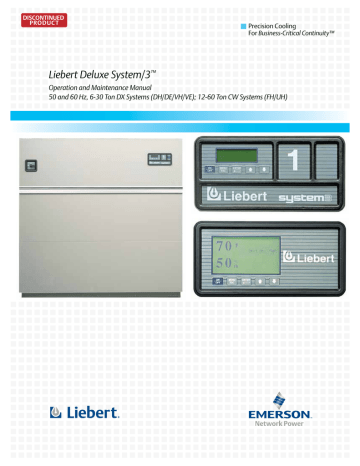Response by Control Type—Advanced Microprocessor Controls
Hot Water/Steam Heat
The valve begins to open when the requirement for heating is 33% and is proportionally adjusted until the valve is full open at 100% heat requirement.
5.2
Humidity Control
5.2.1 Dehumidification/Humidification Required, in Percent (%)
The humidity control program for the Advanced Microprocessor is based on a calculated % requirement for dehumidification/ humidification. This % requirement is determined by the particular type of control algorithm selected by the user.
5.2.2 Control Types
Proportional Control
The % requirement is determined only by the difference between the return air humidity and the humidity setpoint. As the return air humidity rises above the humidity setpoint, the % dehumidification required increases proportionally from 0 to 100% over a humidity band equal to the humidity sensitivity setting. The converse is true for % humidification requirement.
PID Control
If PID Control is selected, humidity is controlled in the proportional mode with the sensitivity band being determined by the humidity sensitivity setpoint.
Intelligent Control
If Intelligent Control is selected, the return air humidity is controlled at or near the humidity setpoint. The % dehumidification/humidification required is calculated based on a set of logical “rules” that simulate the actions of an expert human operator (see Intelligent Control on page 35).
5.2.3 Dehumidification Operation
One-Stage Dehumidification, Compressorized Direct Expansion (DX) Systems
If single compressor dehumidification is selected, a compressor is activated when the humidity control calculates a requirement of 100%; the compressor is deactivated when the requirement falls below
50%.
Two-Stage Dehumidification, Compressorized Direct Expansion (DX) Systems
The first stage of dehumidification activates when the humidity control calculates a requirement for dehumidification of 50%. The first stage of dehumidification is deactivated when the dehumidification requirement drops below 25%. The second stage of dehumidification is activated when the requirement for dehumidification rises to 100% and deactivated when the requirement falls below 75%. If the compressors have unloading capability (four-step cooling), then the compressors are activated in the fully loaded condition for each stage of dehumidification.
Normal or Delayed Reheat (for Two-Stage Dehumidification Only)
If the return air temperature falls enough to require more than the total available reheat capacity, then one (1) stage of dehumidification is disabled and the reheats are activated. If the return air temperature falls enough to require twice the total reheat capacity (200%), both stages of dehumidification are disabled. One stage of dehumidification will be re-enabled at 66% call for heating. Both stages of dehumidification are re-enabled at 33% call.
If delayed reheat is selected and both compressors are activated for dehumidification, the reheats are disabled until only one compressor is required.
If normal reheat control is selected, then the reheats are not disabled during dehumidification, even if both compressors are operating. Refer to section 3.4.2 - Setup System Selection and 4.8.4 - DIP
Switches
regarding wiring required for this option.
35
DISCONTINUED
PRODUCT
